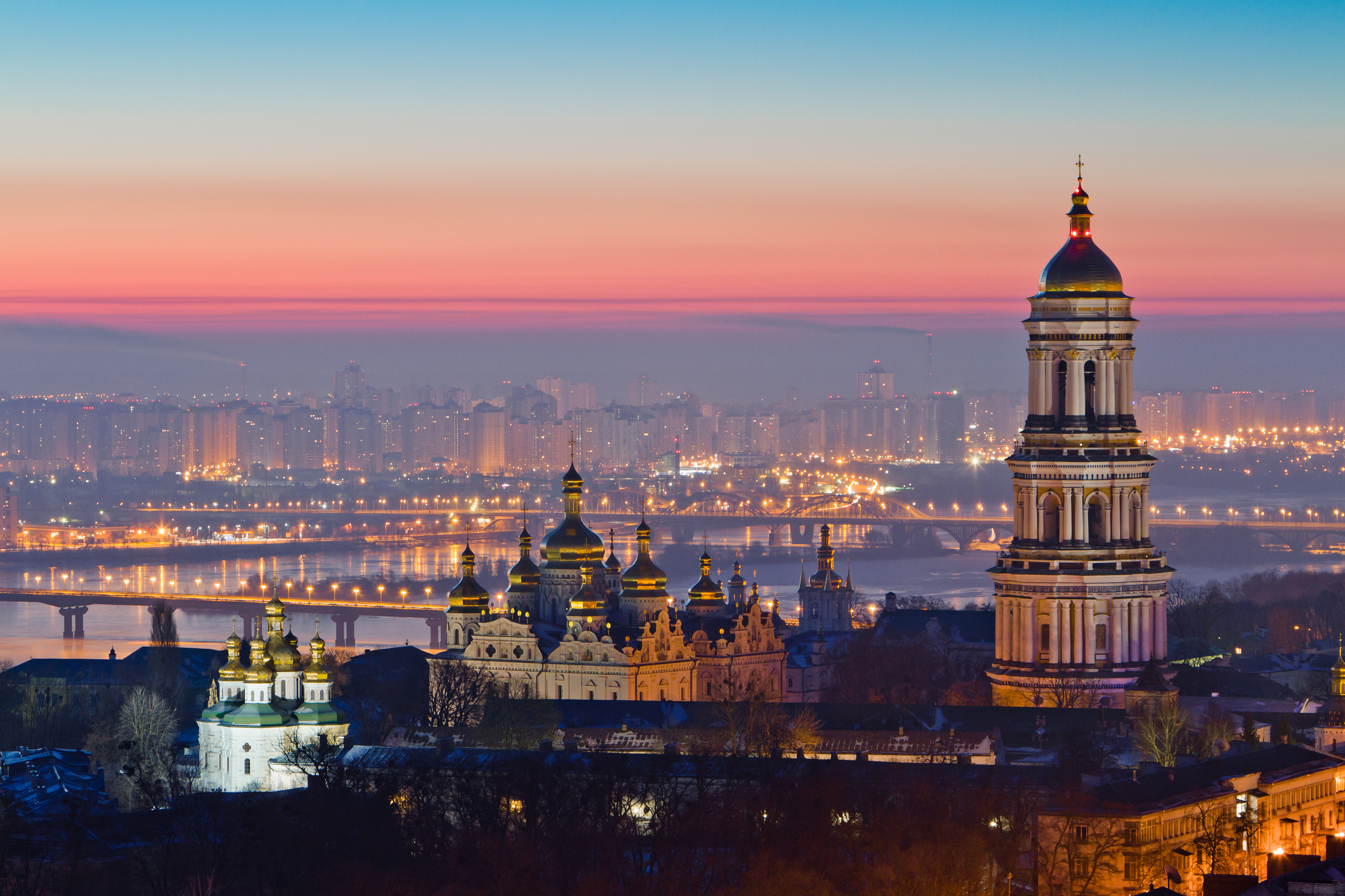Note: This story was conceived and written before Russia’s invasion of Ukraine. Apart from the addition of updates to reflect recent developments, we chose not to substantially alter the piece. The ongoing war has turned this narrative into its own monument to the effort to build a worthy memorial at Babi Yar—a project whose future is now in doubt.
ON AN ORDINARY WEEKDAY in November 2019, Yana Barinova, the executive director of the Babyn Yar Holocaust Memorial Center (BYHMC), was summoned along with her staff to a meeting in the glass conference room of a Kyiv business center to discuss the future of their project. The team had been tasked with building a $100 million memorial museum to sit on the grounds of the site just outside the Ukrainian capital—known in Russian as Babi Yar—that has been called “Europe’s biggest mass grave.” But in the past several weeks, the staff had become aware of rumors that a parallel BYHMC office had opened elsewhere in Kyiv, run by the eccentric 46-year-old Russian film director Ilya Khrzhanovsky. “People in Kyiv were starting to gossip about it,” Barinova said. “[Khrzhanovsky] had started hiring a shadow team that was duplicating and auditing our work.” That day in the conference room, Khrzhanovsky—his face dimpled beneath a boyish mop of brown hair, his demeanor deliberately disarming—presented himself to her team for the first time as the project’s new artistic director. “It was a bit of a surreal situation, because on the one hand, all of us were still employed, yet here was this new management that had never been officially communicated or introduced,” Myron Wasylyk, Barinova’s chief communications officer, recalled. Khrzhanovsky announced that their office was being shut down and their team would be integrated into his. As he began to describe his vision for the memorial, the staff grew increasingly unnerved. “Ilya had a whole different viewpoint,” Wasylyk said. “His scale was super grand.” Whereas Barinova had emphasized the task of “solemn memorialization,” he said, Khrzhanovsky “was focused on making more of an attraction.”
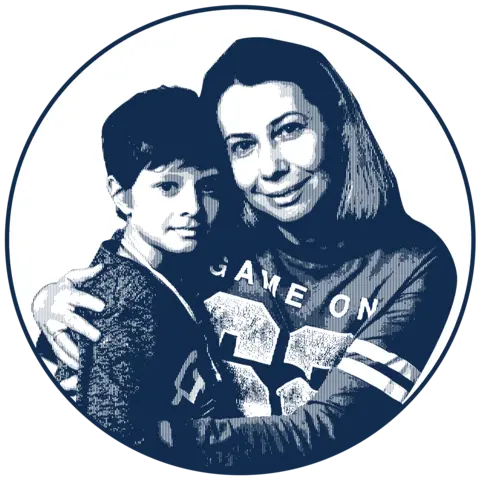
As a nonprofit journalism organization, we depend on your support to fund coverage of global conflicts. Help us continue funding the hard costs of in-depth coverage of the Ukraine invasion—including travel, hostile environment safety training, and the increased security expenses that arise from reporting in war zones.
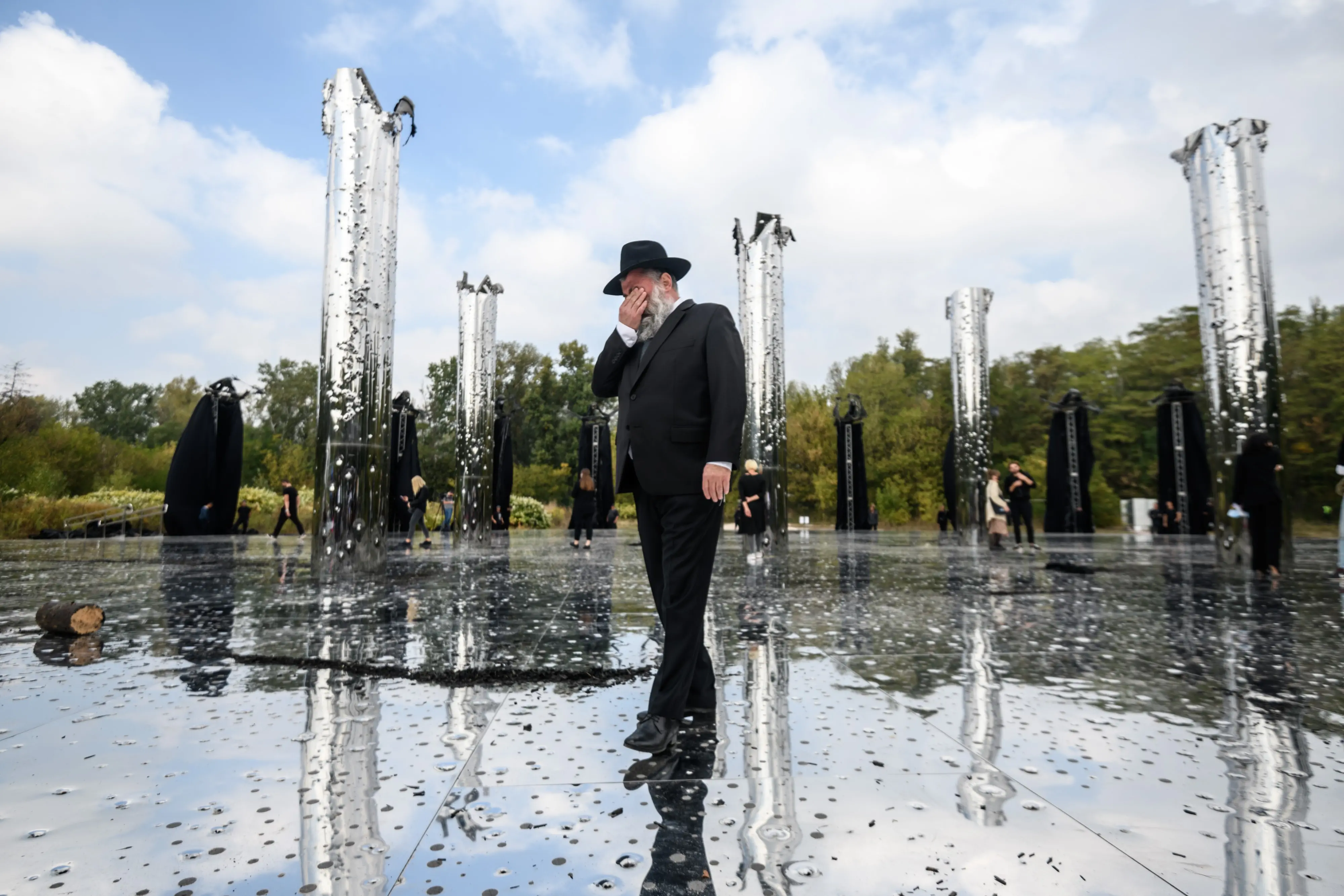
At the ceremony, the oligarchs and members of their supervisory board stood together before a screen that represented their project as a shadowy white square atop a bleach-white background: a void on top of a void. No one knew what they would build, who it would be meant for, or what story it would tell.
Barinova, now 33 years old, had spent years working nonstop to make the museum a reality. The BYHMC had officially launched on September 29th, 2016, the 75th anniversary of the German massacre of the Jews of Kyiv. To some, the BYHMC’s reckoning with the past promised to propel the country toward a European future, proving that Ukraine was a liberal, democratic nation, and attracting much-needed foreign capital and tourism revenue. At an afternoon ceremony that day, Ukraine’s then president, Petro Poroshenko, had formally announced the project, which would be financed entirely through private funds. Among the lead donors were the oligarchs Mikhail Fridman, German Khan, and Pavel Fuchs, all of whom were born to Jewish families in Ukraine, and who are known to have ties to the Kremlin and to have made the vast majority of their wealth in Russia. Thirteen of Khan’s relatives were killed at Babi Yar, and other funders lost relatives at killing sites elsewhere in the country. They promised to build the biggest and most impressive Holocaust museum in all of Europe, one that would inaugurate a new era of memorialization. They also promised it would be unveiled in five years, in time for the 80th anniversary of the massacre. At the ceremony, Barinova posed for photographs and posted them to her Facebook page, celebrating her appointment as executive director. The oligarchs and members of their supervisory board—which included Natan Sharansky, the Israeli politician and Soviet dissident; Rabbi Yaakov Bleich, one of the chief rabbis of Ukraine; Vitali Klitschko, the mayor of Kyiv; and Svyatoslav Vakarchuk, a pop star and politician—stood together before a screen that represented their project as a shadowy white square atop a bleach-white background: a void on top of a void. No one knew what they would build, who it would be meant for, or what story it would tell.
At first, the center’s approach seemed respectfully cautious and unimpeachably conventional. Barinova, who had herself lost relatives at a killing site near Rostov-on-Don, Russia, began by assembling a small staff of experienced, internationally trained professionals. Her vision drew upon the aesthetic and narrative examples of the US Holocaust Memorial Museum in Washington, DC, and Yad Vashem in Jerusalem, both of which she visited to consult with their directors and archivists. “From my point of view, memory is modest,” Barinova told me. “Less is more.”
The project changed slowly, and then all at once. In May 2019, Wasylyk was invited to a board meeting with Fridman. When he arrived, he discovered that Fridman had also invited the French writer Jonathan Littell, author of the Holocaust novel The Kindly Ones, and Khrzhanovsky, the director behind the notorious filmic “art piece” Dau, which recreated life in and around a famous Soviet laboratory in what the The Guardian dubbed a “Stalinist Truman Show.” Wasylyk had heard rumors that Fridman was underwhelmed with the direction of the BYHMC. It was said that the proposals for the museum design, in particular, seemed to him to be too safe, too predictable, too similar to museums elsewhere. “Instead of being a five, he thought they were a solid four,” said Wasylyk. “They did not represent his ego.” At the meeting, “Ilya criticized the direction of the project in general,” Wasylyk said. And Fridman listened.
At first, Fridman and other donors proposed that Barinova and Khrzhanovsky could somehow combine their approaches. In a show of good faith, Barinova flew to London to see a private screening of Dau. “I saw what he had been doing for the last ten years, and I thought, ‘It’s not appropriate for memory in Ukraine,’” she said. Dau was an “independent artistic project,” she explained—it represented the vision of a single person and would not lend itself to the project of “institution building” with which she had been tasked. “When you work with national memory, it’s very deep and slow,” she said. “I think that our supervisory board wanted to see quick wins.” She left the project at the end of 2019, along with most of her staff.
Soon, the public got a glimpse of the kind of “quick wins” Khrzhanovsky was promising. In April 2020, the Ukrainian newspaper Ukrayinska Pravda published a leaked presentation detailing his purported plans for interventions across Babi Yar’s 370-acre site. His approach seemed designed to make visitors feel as if they were present at the massacre, which took place in broad daylight, on a barren landscape riven with steep sand walls and hidden ravines. According to the leaked document, Khrzhanovsky imagined building a maze and “corridors of complete darkness” in order to deliberately disorient visitors, to make them feel helpless and lost. He planned to use facial recognition technology to give visitors an emotional “score” and conscript them into various roles, including victim, collaborator, Nazi, and prisoner of war. “Virtual-reality role-playing routes” would then determine how the visitors navigated the site. The images of their faces would be combined with that of their avatars in order to “create a connection” between past and present—and, presumably, to augment the disorientation. One of the images accompanying his concept was a rendering of Hieronymus Bosch’s Harrowing of Hell, a surreal and chaotic scene of blood and fire.
The leaked presentation provoked near-unanimous outrage. A member of the BYHMC staff claimed that it had been a mere “brainstorm,” that the ideas it contained had never been approved. (Wasylyk, the former chief communications officer, said that was “bullshit” and surmised that Khrzhanovsky had in fact been hired on the basis of the ideas in that same presentation.) Leading Ukrainian writers, scholars, and politicians signed an open letter asking the BYHMC to remove Khrzhanovsky from his post. Dieter Bogner, an Austrian expert in museum design who worked with Barinova, wrote a furious letter to the BYHMC, arguing that the plans came “dangerously close to a Holocaust Disneyland.” Karel Berkhoff, the leading historian overseeing the project’s narrative, was part of another wave of protest resignations. “To shock and provoke is fine in the field of art, when people choose to go to a certain museum, but here you have a place that must serve lots of different people, some of whom just want to commemorate their family,” Berkhoff told me, speaking via Zoom from Amsterdam. “This place is going to be shocking always. It has a lot of atmosphere by itself.” He saw in Khrzhanovsky’s approach “a lack of concern about how it will land with the people who are most closely involved in the history. Think of a person who had a grandparent who was murdered there. Isn’t that at all a factor here? Apparently not.”
Khrzhanovsky’s approach seemed designed to make visitors feel as if they were present at the massacre, which took place in broad daylight, on a barren landscape riven with steep sand walls and hidden ravines. According to the leaked document, he imagined building a maze and “corridors of complete darkness” in order to deliberately disorient visitors, to make them feel helpless and lost.
When I read about Khrzhanovsky’s plans to use facial recognition to sort visitors into different categories, I could not help but wonder what it would make of my own face. My parents left the Soviet Union during perestroika; on my mother’s side there are victims, on my father’s side, perpetrators. Which way would his imaginary algorithm tell me to walk? My grandparents were not among the Jews of Kyiv who, on Erev Yom Kippur, 1941, were told to deposit their suitcases and strip; who were marched in groups to the top of a ridge, lined up, and shot into a sandy abyss. My grandmother Esther had been evacuated from Kharkiv to Kazakhstan, and my grandfather Mikhail, who grew up outside Kyiv, was in Moscow with his Soviet army regiment. His cousin Fanya survived only because she had been sent to stay with my great-grandparents in a town 50 kilometers away. His aunt Klara, her husband, and one of their children—sophisticated city-dwellers, the most refined of the family—were not so lucky. They were among the nearly 34,000 Jews shot over the course of those two terrible days.
Babi Yar represented “the very first time in history [that] a metropolitan city in Europe lost virtually all of its remaining Jewish inhabitants to premeditated murder,” Berkhoff writes in a report on the site. It has been called the place where the Holocaust “began,” the site of the single largest mass shooting of Jews in what is now referred to as the “Holocaust by Bullets”: the Holocaust that preceded the gas chambers, the Holocaust conducted in close proximity, the perpetrators aiming their guns at their victims’ backs. This was the Holocaust visited upon large swaths of Eastern Europe in the early years of the war, the Holocaust that wiped out the old Jewish communities of the Pale of Settlement and beyond. Precisely how many people the Germans murdered at Babi Yar will, perhaps, never be known. The killings continued for years. Some studies suggest that 100,000 people were murdered there in total during the war, while others have claimed that the real figure was approximately double that.
Babi Yar represented “the very first time in history a metropolitan city in Europe lost virtually all of its remaining Jewish inhabitants to premeditated murder.”
For many decades, the mass grave went unmarked. In 1961, when Soviet authorities had all but suppressed the memory of Babi Yar and people had learned not to speak publicly of what happened there, the writer Yevgeny Yevtushenko published his now famous poem named for the site, with its immortal first line: “No monuments stand over Babi Yar.” His words continue to haunt the territory even as a number of discrete memorials have sprung up there: each new statue disconnected from its predecessors, each one honoring a different group of the dead—Jews, Roma, Ukrainian nationalists, children, Soviet POWs, forced laborers, mudslide victims, psychiatric patients, priests—as if each mass murder was a distinct event unrelated to the cataclysmic whole. This chaotic field of commemoration deepens the sense of Babi Yar as an abidingly impossible place: a place where graves are layered upon graves, and where Jewish law prohibits their disturbance—a place where it is forbidden to build, and simultaneously, where building has become the primary mode of remembrance. It has been destroyed not once or twice but many times over, almost recursively—by Germans, by Soviets, by nature, by greed. Each new act of obliteration has brought up the bodies only to submerge them once more.
I have spent years paying visits to this place. At first, I was shocked by its terrain, by the casualness with which the locals seemed to traverse it, by the unfathomably deep metro tunnel that cuts into its ashen soil. It made me feel slightly ill. Six years ago, I got lost trying to find the memorial I was looking for—there were few markers telling visitors which way to walk. I mistook one of the extant ravines for the one where my relatives were killed, not yet understanding how thoroughly the site had been destroyed and remade in the intervening decades. Every subsequent visit, a new memorial. My shock receded, but the nausea remained. “Babi Yar has been like the Lethe, the river of oblivion in the ancient Greek underworld,” Berkhoff writes. The more one drinks of the river Lethe, the more one forgets; the more memorials I encountered at Babi Yar, the more memory—and the unending project of memorialization—seemed to become slippery. When I returned to the site in September, all I found myself wanting to look at was the soft and soot-colored ground.
At the time, Russian troops had already begun massing along the Ukrainian border, preparing to unleash an unprecedented assault on the nation’s sovereignty, though no one knew it yet. By then, I had come to hear Yevtushenko’s lines as a prophecy, or even a curse. Now I see the poem as a document of a darkening reality, an account of living with denial and obstruction. I have been rereading it as the advancing Russian army threatens to bring with it yet another oblivion and the devastation of Ukraine’s democratic dream.
BABI YAR HAS ALWAYS been a burial site. Before World War II, it was occupied by different cemeteries—Jewish, Orthodox, Muslim, and Karaite. Most of the tombstones disintegrated long ago, and today the boundaries of the cemeteries are disputed, their remains dispersed. For well over a century, the territory has been called “Babi Yar,” or “Babyn Yar” in Ukrainian, which means “Old Women’s Ravine.” The Russian Imperial army used part of it as a shooting range, the Red Army used it as a camp, and civilians used it as a leisure park.
After Kyiv was liberated from the Germans in November 1943, Soviet soldiers arrived at the ravine and saw the place where the earth had been disturbed. The writer Ilya Ehrenburg, himself from Kyiv, was with them. “I never felt so orphaned as I did standing at Babi Yar, where I imagined my friends and family lying in the sand,” he wrote of that moment. Vasily Grossman, the great chronicler of the Soviet period, arrived in Ukraine in 1943 and was shocked by the silence he encountered, a silence “more horrifying than tears and curses,” for it conveyed just how many people had been killed. “In Ukraine there are no Jews. Nowhere—not in Poltava, Kharkov, Kremenchug, Borispol, not in Iagotin,” he wrote. “This is the murder of a people . . . the murder of the tree of life: this is the death of roots, and not branches or leaves; it is the murder of a people’s body and soul.”
The Soviets rigorously documented and publicized German crimes. They brought journalists on tours of the ravine and presented them with eyewitnesses; they planned to build a two-million ruble museum to the “Kyivans” murdered there, a project that was never realized. And then, once again, there was silence. The Jewish catastrophe was submerged beneath the wartime tidal wave of Soviet casualties, as if the site of mass murder had been a mere battlefield. Antisemitic violence was not uncommon in postwar Kyiv, and the emerging Soviet doctrine condemned cosmopolitanism, liberalism, and “bourgeois nationalism”—terms that were projected upon Jewish intellectuals and cultural organizations, all of which would be liquidated in the coming years. In 1944, Grossman and Ehrenburg, who had encountered one another in their travels with the Soviet Army, worked to assemble The Black Book, an immense compilation of testimonies and records attempting to document everything that had been lost in the “ruthless murder of Jews by Fascist German Invaders”; the book was distributed abroad in 1946 but banned within the Soviet Union because authorities saw it as an artifact of Jewish nationalism. The manuscript was destroyed. When, that same year, elderly Jews requested permission from the Chairman of the City Soviet to gather and pray over their dead relatives, they were denied and later told that assembling would mark them “as an underground organization . . . opposed to the Soviet regime.” Meanwhile, the ravine festered, the city’s open wound. Some locals hunted for gold among the remains; others used it as a trash dump.
As the Soviet population rebounded, authorities sought to put the cursed land to work: Beginning in 1950, the ravine was deliberately flooded, filled in, smoothed over. Where once there were mass graves, there were soon apartment blocks, a swimming pool, a hospital, a sand quarry, a brick factory. The killing site itself was flattened and absorbed into a sprawling park. The writer Viktor Nekrasov protested a 1959 proposal that included the construction of a football stadium on its grounds; his letter was the first public acknowledgement of what had occurred there.
Where once there were mass graves, there were soon apartment blocks, a swimming pool, a hospital, a sand quarry, a brick factory.
In 1961, a mudslide obliterated what was left of the ravine, swept up its buried human remains, and killed hundreds of people. Some saw it as a divine act of revenge. Yevtushenko went to survey the damage. His anger at the sight of old Jewish tombstones overturned and bone fragments peeking through the mud drove him to write his famous poem, breaking what he called the “conspiracy of silence.” The poem circulated as samizdat, dissident literature passed from hand to hand, and was later published in the Literaturnaya Gazeta. (The editor only agreed to print it after consulting with his wife, for he correctly predicted that he would lose his job as a result.) When the composer Dmitri Shostakovich wrote his Thirteenth Symphony to Yevtushenko’s words, the symphony was banned after two performances.
Yevtushenko’s poem received a global audience, but domestic suppression of the subject of Babi Yar continued. In 1965, Soviet authorities reluctantly opened an architectural competition for a memorial to the victims, but rejected all of the proposals without explanation. In 1966, Soviet writers and Jewish activists attempted to hold an unofficial commemorative gathering at the site in honor of the 25th anniversary. They retraced the path that the victims had taken to their deaths, trailed by KGB photographers taking inventory of the “nationalist Jewish citizens” who participated (when the mourners saw the cameras, most of them dispersed). The first official memorial would not appear until 1976, when the Soviet government erected a stone monument honoring the “Soviet civilians” and prisoners of war “who were shot at Babi Yar by the German occupiers.” To the Jewish community, it was a slap in the face: Like virtually all Soviet World War II memorials, it strategically omitted the identity of those who were murdered, as well as the genocidal nature of the crime.
After the fall of the Soviet Union in 1991 came the memory boom: The site exploded with memorials. That September, on the 50th anniversary of the massacres, the local Jewish community unveiled a bronze memorial in the shape of a menorah. In 1992, a large wooden cross went up in honor of the 632 Ukrainian nationalists killed there, some of whom had collaborated with the Nazis before being murdered by them. More memorials followed, and then still more. Throughout the former Soviet Union, memorializing murdered Jews became a primary indicator that the newly independent nations were ready to join the European family, that they had recognized and atoned for past wrongs. Preparation to build a Babi Yar museum began in 2001, but the project was scrapped after local Jewish groups protested against further construction upon human remains. A carved stone marks the site of another failed attempt at a “memorial-museum complex” from 2011.
Today, the territory is not only a literal graveyard but also a “graveyard of memorials—a palimpsest of failed efforts to grapple with this event,” as the scholar Victoria Smolkin, of Wesleyan University, told me. “As of 2015, Kyiv has no Babi Yar museum and lacks even a semblance of consensus concerning the precise location of the shootings and the victims’ remains,” Berkhoff wrote that year. “There is no agreement on the proper way to treat the killing site, which has been encircled by the rapidly growing city since the war.” In 2015, antisemitic assailants crowned the menorah with tires and set it aflame. Until the war broke out in Kyiv, an active shooting range occupied part of the historic site. If you listened closely, you might have heard the sound of rounds being fired through the air.
I WAS ON ASSIGNMENT at Babi Yar for the 75th anniversary in 2016, covering the ceremony and all that it meant—or was supposed to mean—for Ukraine’s political future. I interviewed American dignitaries, Jewish leaders, and museum officials who had flown in for the event, many of whom bemoaned the current state of the site and expressed tepid hope for its improvement. On the evening of September 29th, we sat in the dark on folding chairs set up in the grass, watching politicians give speeches about what had happened there and how the time had come for reckoning. When the ceremony was over, everyone walked together down a newly paved stone path known as the “Road of Sorrow,” which some believe to be the path that victims walked to their deaths. I walked beside a pair of Orthodox priests, who stopped in front of the bronze menorah and asked me to take their photograph.
Earlier that day, when Ukraine’s then president Poroshenko had announced the creation of the BYHMC at a press conference in the city center, he had cast the project not only as an overdue memorial to Ukraine’s murdered Jews, but also as an important step in the nation’s Europeanization. Poroshenko, a chocolate magnate, had been elected in the aftermath of what is now known as the Ukrainian Revolution of Dignity, the 2014 uprising that attempted to free Ukraine from Moscow’s control. The revolution began when the Kremlin-backed former president, Viktor Yanukovych, refused to sign an association agreement with the European Union, acting against the wishes of his people; within months, Kyiv’s central square became the site of revolutionary violence, eventually forcing Yanukovych to abandon his residence and flee to Russia. Ukrainians were—and are—willing to fight and die for the freedom to choose their own future.
While some saw the involvement of the oligarchs Fridman, Khan, and Fuchs as a guarantee that a worthy memorial would be built at long last, others were suspicious of the donors’ ties to the Kremlin. With the war still smoldering in eastern Ukraine, some politicians, historians, and Jewish leaders could not abide the introduction of more Russian money into the center of Kyiv—the same money, they argued, that was being used to kill their troops on the front line. The Security Service of Ukraine (SBU) investigated allegations that the project was a potential national security threat, and pundits worried that it was a Russian land grab in disguise. (In a letter to the BYHMC, the SBU said that it had found no basis for the allegations against the organization.) “Why is Putin at Babyn Yar?” one media segment asked; a Kyiv think tank argued that the project was a “trap” designed to increase Russia’s soft power over Ukraine. Opponents began referring to the BYHMC as the “Russian Project,” and threw their support behind a “Ukrainian Project” launched by a coalition of Ukrainian academics who had devised their own extensive proposal for the site. Public concern stemmed not only from the sources of the project’s funding, but also from the question of how it would present the complicated history of Babi Yar. Commentators worried that the BYHMC would portray Ukraine as a nation of fascists and Nazi collaborators, in line with the propaganda of Russian media outlets. Members of Parliament attempted to block the project in committee; a lawsuit filed against the Ministry of Culture sought to ban the construction of a synagogue that was part of the plans for the new memorial complex. The intense apprehension over what would be built at Babi Yar reflected Ukrainians’ profound anxiety over what their nation would become, and who would have a say in its construction.
“Why is Putin at Babyn Yar?” one media segment asked; a Kyiv think tank argued that the project was a “trap” designed to increase Russia’s soft power over Ukraine.
Barinova and her staff understood that the involvement of Russian oligarchs threatened to compromise their project, but believed their task was urgent enough to carry on regardless. A June 2021 poll conducted by the Kyiv International Institute of Sociology found that over 40% of Ukrainians did not know what had happened at Babi Yar. Ukraine is engaged in a “war of memories,” Barinova told me. “We have conflicting memories, we have a competition among victims,” she said. “We should say, ‘Yes, we had collaborators, and we also had Righteous Among the Nations,’” a term for those who risked their own lives to save Jews. Creating opportunities for public discussion of this history, she told me, is a step toward “building a democratic country” in Ukraine. A successful memorial would have to consolidate the complexities of Ukrainian national memory, creating a shared understanding of the site. To that end, Barinova formed an academic council to collectively author a historical narrative, and asked Berkhoff, the leading scholar of Babi Yar, to helm the process. Her team planned to incorporate the existing monuments into the new memorial complex, and to build a single, centralized museum that would attempt to unify the chaos. The approach aimed to bring coherence to the site—and the story behind it—without seeming to dictate how the broader park should be used.
Barinova’s approach aimed to bring coherence to the site—and the story behind it—without seeming to dictate how the broader park should be used.
To mitigate allegations of Russian influence, Barinova involved as many influential Ukrainian stakeholders as possible; the official name of the BYHMC was also changed from “Babi Yar” to “Babyn Yar” during her tenure, trading the site’s Russian name for its Ukrainian one. She also engaged international experts, launching an architectural competition for the museum design. The winning proposal, a subterranean, glass-and-steel design submitted by the Austrian firm Querkraft Architekten, was consciously plotted to leave much of the land undisturbed. The ravine itself “is already the proof” of what happened, said Kateryna Kovalchuk, a member of Barinova’s team who was in charge of the competition. The plan drew from familiar memorial techniques; its use of landscape and depth was reminiscent of the US Vietnam Veterans Memorial and the National Museum of African American History and Culture. According to the firm’s description of the design, visitors would first be led downwards into the “dark abyss of the past,” where they would encounter historical exhibitions about the events. Then they would slowly make their way back to ground level, ultimately emerging into a light-filled “democratic space,” seemingly intended to represent a “bright, positive, open” future. To exit the memorial, visitors would undertake a “respectful walk through the forest,” which the architects hoped would allow them time to reflect on all that they had seen. “The forest might appear in a different light,” they write in their project proposal. “And the visitor might ask himself: Has the forest changed? Or have I?”
To BYHMC’s supervisory board, the Austrian proposal was too conventional. “They didn’t feel a ‘wow’ effect,” Barinova said. “Maybe the winner of the architectural competition was not so impressive,” she reflected. “But it was a fair process.” To her, the democracy of the method was more important than the design itself. Her vision—which Khrzhanovsky would quickly supplant—had sought to use what the researcher Samuel Holleran has dubbed “Shoahtecture,” a class of “high-flying, capital-A architecture” that aims to contain Holocaust history within the mediated, sanitized space of the museum. These constructions, he suggests, act almost like crypts for uncomfortable histories, so much so that they paradoxically serve as the “first step towards forgetting.” Khrzhanovsky’s plans, however controversial, notably took the opposite approach, aiming to confront visitors to the site with striking, seemingly omnipresent reminders of its past. He sought to make it impossible for anyone to stroll through the park without realizing what had happened there.
THE FIRST TIME Khrzhanovsky visited Babi Yar, in the spring of 2019, he felt “disappointed, and in a way shocked,” he told me. He was speaking via Zoom during a visit to Tel Aviv. His background featured a dotted outline of the ravine, which is the logo of the BYHMC, and the words “Babyn Yar: Memory Place” hovered behind his head. Khrzhanovsky had heard about Babi Yar all his life: Both his father and grandfather were celebrated Jewish artists in Moscow, where Babi Yar was discussed as a central episode of the Holocaust. As he traversed the site, he said, he was struck by the sight of “people drinking beer, walking their dogs, and making kebabs in the same place where tens of thousands of people were burned.” He walked past the existing memorials, past the wooden Orthodox church where services are held every day, following the paved path until it gave way to a series of forested dirt trails. As he walked deeper into the territory, he began to see people mountain biking up and down the remaining ravines, waving metal detectors at the earth, and gearing up for a game of paintball on the grounds of the abandoned psychiatric hospital. He saw old tombstones defiled with graffiti and trees carved with swastikas. It all filled him with a sense of wrong.
He began to think about what it would take to alter how people traversed the site. “When I started to walk there, I immediately got it,” he told me. “This is a sacred, dangerous, raped place. This soil, and this land, is a holy land. You cannot change it—you can only respect it.” He had read that the trees growing over the site of the mass grave were distinct from others on the terrain—nature had made its own quiet memorial to the murdered. “For me this place is a body,” he said. “What can you do with a body?” He nodded toward the ring on my finger. “You have a ring on your hand,” he said. “But you didn’t cut your finger.”
His concern for the sanctity of the body surprised me, for it seemed to be at odds with much that I had read about his artistic approach. Dau had become infamous as one of the strangest productions in film history. From 2009 to 2011, some 300 people lived at any given time on what was less a film set than, in Khrzhanovsky’s words, a “meticulous historical simulation.” An abandoned aquatic stadium in Kharkiv, Ukraine, was converted into a miniature city, complete with streets, buildings, and apartments designed to replicate life in 1950s Moscow. The cast—a few hired actors, but mostly volunteers and curious hipsters—was costumed in period clothing and made to live, work, and sleep in what Khrzhanovsky called his “experiment,” while a single cameraman roamed the premises. One crew member likened the conditions to “slavery,” while others wondered if they were not on a film set but living in some strange replication of the Stanford Prison Experiment. Khrzhanovsky brought real-life neo-Nazis to the set and filmed them terrorizing the cast; he hired former KGB agents and asked them to play themselves; he filmed his lead actress being sexually assaulted in a naked torture scene. Prosecutors from Kharkiv opened a criminal investigation into the production after Khrzhanovsky brought disabled orphans to the factory, an alleged violation of child protection laws that Khrzhanovsky has denied.
Khrzhanovsky’s approach to history is plain: The only way to understand the past, he seems to believe, is to experience it firsthand. His commitment to conjuring a sense of direct access to the 20th century was evident at the offices of the BYHMC—previously the production offices of Dau—where everything from the wallpaper to the table lamps to the candle holders and tea saucers had been painstakingly sourced to convey a whiff of the wartime era. The windows were lined with red velvet curtains, a menorah sat perched atop a small glass bookcase, and a taxidermied pheasant jutted out from a bright green wall. Carved wooden dining tables displayed old black-and-white photos of staffers’ own family members. The majority of the staff is not Jewish, but all full-time hires were required to read Soviet writer Anatoly Kuznetsov’s “documentary novel” Babi Yar and Grossman and Ehrenburg’s The Black Book. Behind every door, a new duo or trio of staffers sat hunched over their laptops, their glowing screens clashing with the anachronistic furnishings. When Ruslan Kavatsiuk, the amiable and harried deputy general director of the BYHMC, led me through the space on a weekday afternoon in late September, he explained that the period furnishings made the staff “feel closer” to the events they were tasked with depicting. “It gives you the feeling that all of this stuff is not from 300,000 years ago,” he said. “People sat on these chairs, and this chair is here. It gets you into the subject in a real-life way.” I could not help wondering where the furniture had been purchased, and if anyone had bothered finding out to whom it had originally belonged.
Khrzhanovsky’s approach to history is plain: The only way to understand the past, he seems to believe, is to experience it firsthand.
Khrzhanovsky applied aspects of Dau’s methodology to his vision for the BYHMC. As part of the Dau casting process, he required many of the 10,000 extras to be filmed answering questions including, “What does happiness mean to you?” On the BYHMC’s website, Ukrainians young and old were filmed answering that same question and many others as part of an ongoing “conversation” project. For the Berlin premiere of Dau, Khrzhanovsky sought to build a replica of the Berlin Wall in the city and subject attendees to a “game-like experience” in which they would have to apply for visas to enter. (The Berlin fire services rejected the proposal, citing a lack of escape routes.) The leaked 2020 proposal for the BYHMC similarly sought to replicate historical conditions, to turn one of the worst episodes of human history into a hyperrealist game.
Khrzhanovsky’s commitment to reenactment as a mode of historical experience also inflected the research taking place at Babi Yar. In December 2019, BYHMC hired the Center for Spatial Technologies, an architecture and research firm based in Kyiv, to 3D-model the terrain as it was in 1941. He and his team understand that there is a potent strain of denialism rooted in the contestation of logistical facts, and have concluded that if people can be shown the precise actions the Germans took to orchestrate the massacre—what the land looked like on the night of the killings and how it was subsequently transformed—they might abandon their negationism. “Our aim is to fight this kind of obstruction as much as we can,” Maksym Rokmaniko, the center’s director, told me. Rokmaniko’s team used aerial surveillance images, historic films, and photographs of the site to reconstruct the killings; they created, he said, the clearest picture to date of the route that the Jews of Kyiv took to their graves. They constructed forensic models to show how the thousands of victims—along with SS battalions, police, and prisoners of war—processed down the city streets, and how their bodies piled on top of one another in the ravine.
At first, these reconstructions were abstracted: Rokmaniko’s team did not go so far as to depict the wrinkles in a murdered person’s skin, or the drunken fatigue upon an SS man’s face. But Khrzhanovsky insisted that they make their work as lifelike as possible. “Ilya said we should be respectful of the human body, to make them all extremely detailed, so we had to hire professional sculptors to 3D-model all of these people,” Rokmaniko told me. “I’m not sure it was entirely necessary.” Some of the reconstructions were based on photographs from the site, but other sources came from massacres perpetrated thousands of miles away. During our interview, I felt my stomach turn at the neatly labeled inventory of sculptural models on Rokmaniko’s screen: “Dead Baby’s Front; Dead Baby’s Back; Dead Elderly Front; Dead Elderly Back.” It was certainly realistic, but “respectful” was not the word that came to mind.
Khrzhanovsky likened his approach to memorialization to “the smell of a perfume”—difficult to describe, but distinctive to experience.
When I asked Max Yakover, then the CEO of the BYHMC, about Khrzhanovsky’s vision for the site, he argued that their critics did not understand the urgency of remaking Holocaust history for a new era. “When you’re building a museum, you’re making it for two or three generations into the future,” said Yakover, a 39-year-old Jewish Ukrainian. “If you’re working 60 years ahead, you need to use a different language, a different form. Our job is to find a new language for the Holocaust for the 21st century.” (On February 10th, Yakover announced he would be stepping down as CEO and would stay on as a member of BYHMC’s supervisory board.) Khrzhanovsky, for his part, professed himself unable to describe that “new language” to me, given that it was still in the works. Before the invasion, he planned to build multiple museums across the territory over the next four years, each one dedicated to a different aspect of the site’s history. There was supposed to be a museum about what Khrzhanovsky calls “Soviet oblivion,” referring to the decades-long suppression of memory; a museum dedicated to the mudslide disaster; and a “rehabilitation center for psychological trauma.” A building in the shape of a kurgan, an ancient Ukrainian burial mound—designed by the Berlin-based SUB Architecture Bureau, which has also collaborated with Balenciaga and Kanye West—was slated to open this year. Inside, visitors would have been able to view Rokmaniko’s forensic reconstructions of the two-day massacre using binoculars. When we spoke in late October, Khrzhanovsky likened his approach to memorialization to “the smell of a perfume”—difficult to describe, but distinctive to experience. He said his “new language” would be “interactive, immersive, experiential.” “These are dangerous words for one generation,” he explained, but not for anyone who understands that “technology gives us the chance to tell the truth from different points of view.” In ten years, he told me, the last Holocaust survivors would be dead. “The direct connection with the event will disappear, so you need to create a bridge,” he said. “That is what we are doing.”
ON A COLD and overcast September day in Kyiv, I met Kavatsiuk by the entrance to the metro station that opens directly onto the site where research suggests the Jews of Kyiv were lined up to be shot. Around us, people strolled with their families and chatted on park benches. Kavatsiuk gestured at the flat and placid park before us, the site of the largest mass shooting of the Second World War, now an empty plot of grass and tall willowy trees. “That’s 80 years of oblivion,” he said.
Kavatsiuk led me to a jagged stone cairn with a small viewfinder lens embedded at eye level—one of several such sculptures that Khrzhanovsky’s team has installed throughout the site. I peered through the portal and recognized the photo within as one taken by the Nazi photographer Johannes Hähle, capturing two German soldiers picking through piles of forfeited clothing. I was standing where he had stood and seeing what he had seen through the lens of his camera on September 29th or 30th, 1941. The cairns had gone up over the last year, part of a first attempt to “change the behavior” of visitors by making sure “that people know where they are,” Kavatsiuk explained. He told me that most of the people who live in the area arrived long after the war, when the site had already been obliterated and flooded. “All of a sudden you realize that you live on a huge mass grave,” he said. He led me up to a spot where the forest gives way to the highway. He wanted to show me a luxury high-rise apartment building that had recently been completed across the way, on top of what used to be the western spur of the killing ravine. “To some people, it’s important, and to others, it’s not,” he said. “If you don’t have a memorial here, then nothing stops them from building this monster on top of it.”
We walked together past more cairns, past placards pasted with QR codes (scan them with a smartphone camera, and up come recordings of survivor testimonies, part of the “audio spectacle” designed to guide visitors through the site). We paused by the wooden fences that shielded the construction crews laboring over the large sculptural installations that Khrzhanovsky had commissioned. They are unabashedly ostentatious creations, each one seemingly designed to take up its own Instagram square. One of the pieces, Marina Abramović’s Crystal Wailing Wall, is intended as a “symbolic continuation of the Wailing Wall of the Jerusalem Temple,” according to the BYHMC. Made of coal, it is embedded with Brazilian crystals that can be illuminated at night—a feature that many people described as bizarre, with no obvious connection to the site or its history.
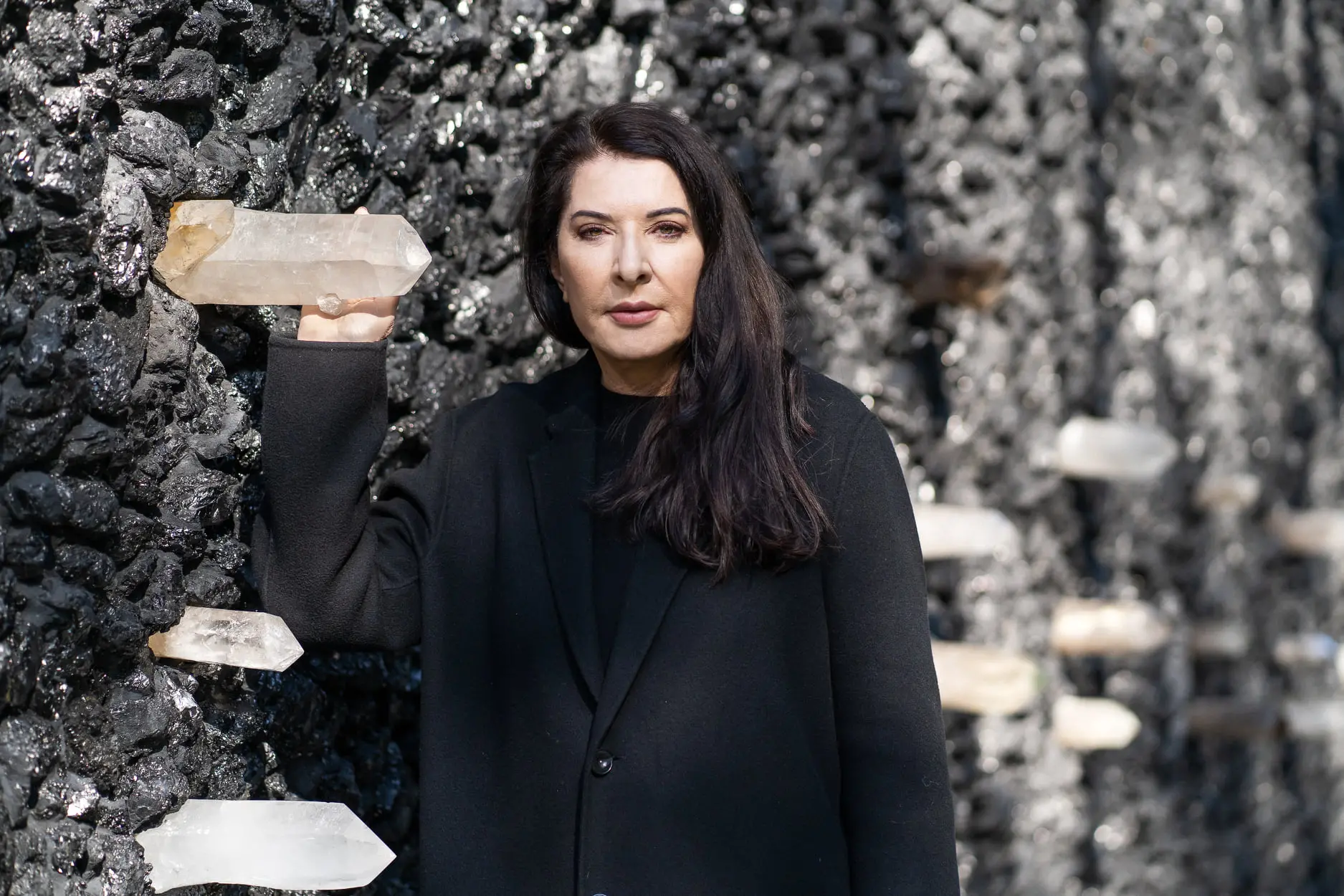
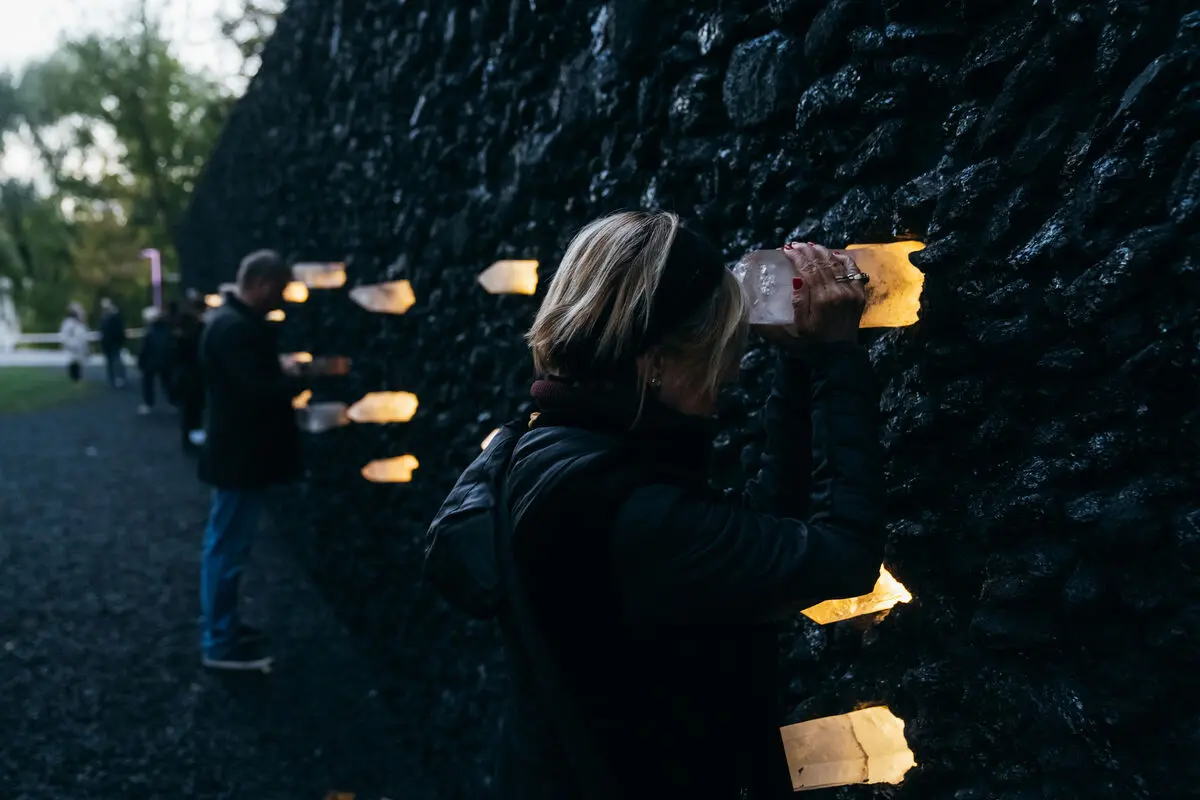
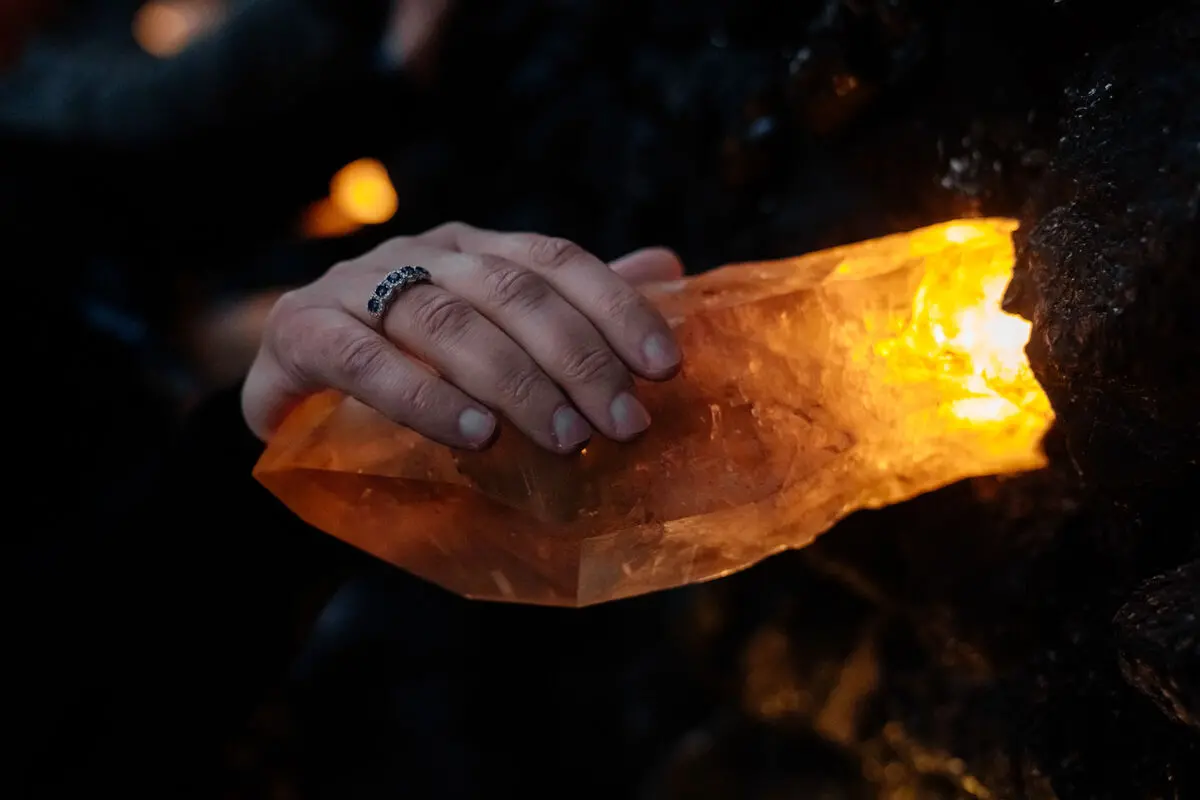
Khrzhanovsky’s large sculptural installations are unabashedly ostentatious creations, each one seemingly designed to take up its own Instagram square.
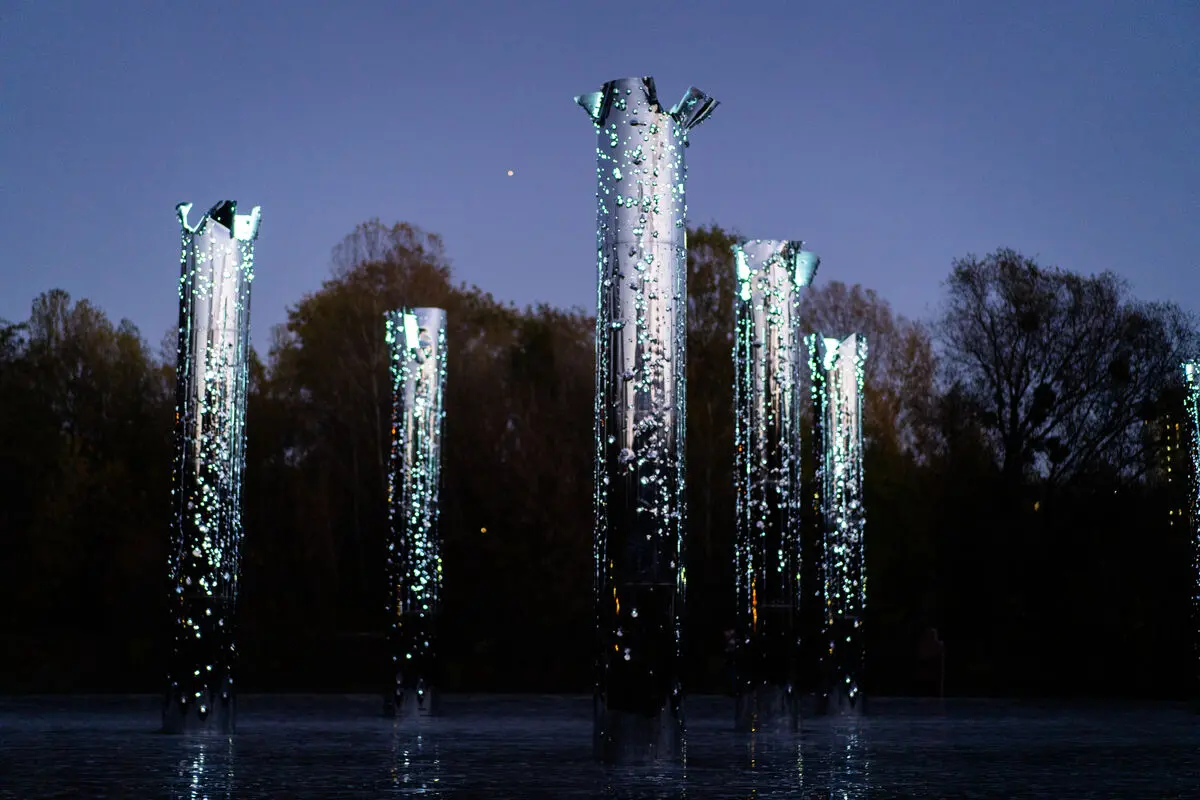
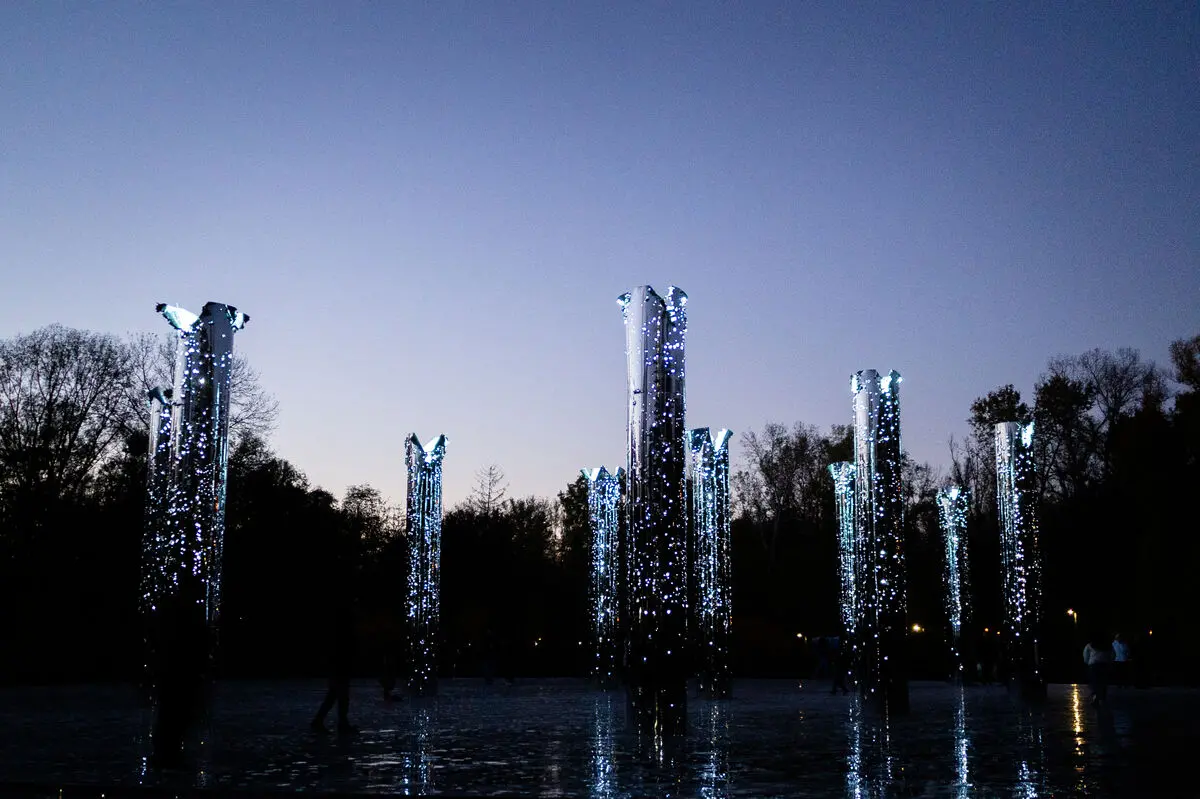
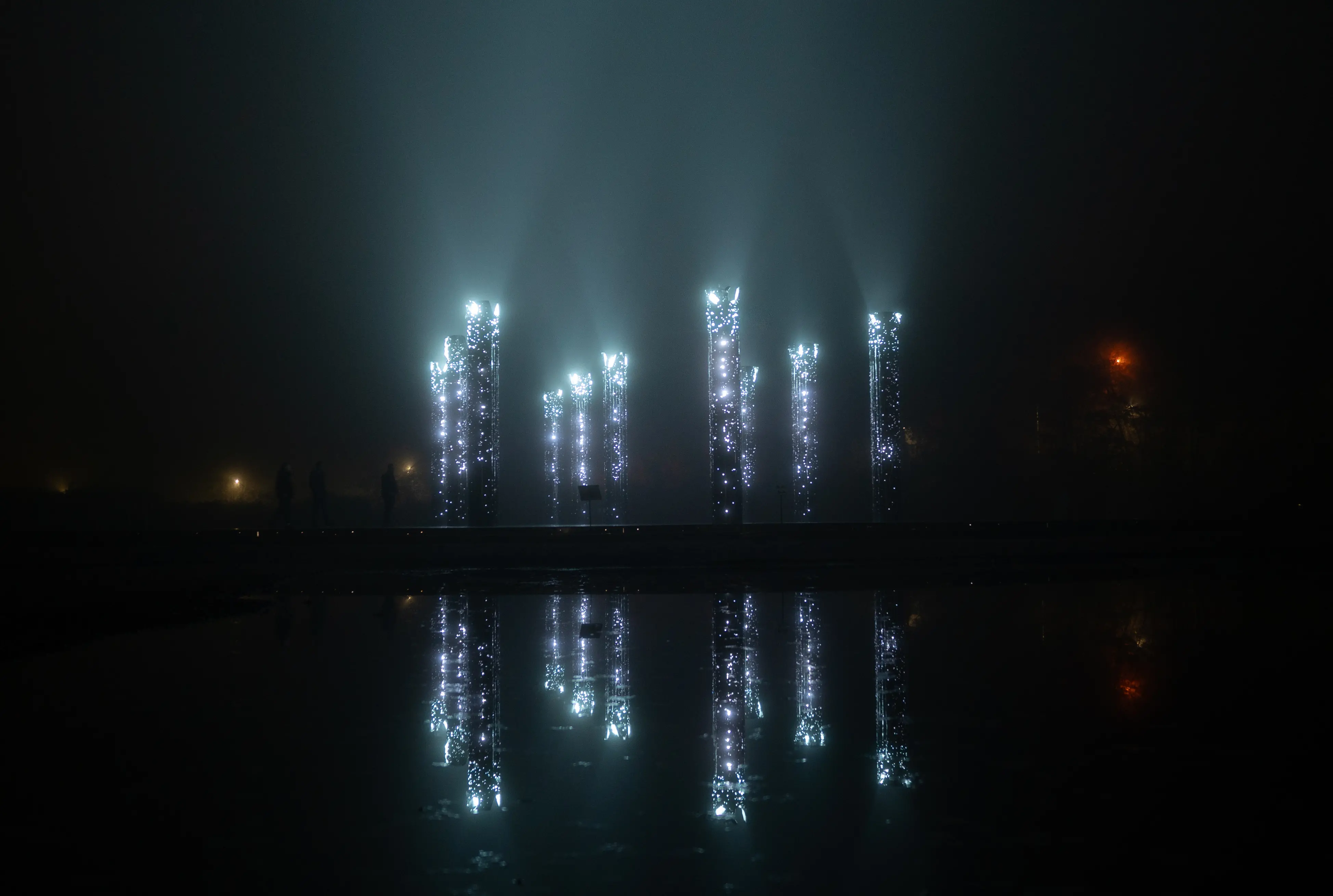
Kavatsiuk walked toward one of the completed installations, a circular, 1,000-square-meter “mirror field” that has been shot through with the same caliber of bullets that were used to carry out the executions. Beneath the platform sits an electroacoustic pipe organ that plays a litany derived from the victims’ names: Hebrew letters have been translated into numbers, numbers translated into notes. As we walked on the reflective, pockmarked stainless-steel platform, the unintelligible rumbling sounds traveled from my shoes up through my bones. Kavatsiuk told me to be careful not to slip and fall, not to run into the mirrored towers that stand six meters high. (Friends of mine in Kyiv told me that I should go back to see it at night, when the towers emitted light beams into the sky and the bullet holes glowed like small stars.)
There was a cost to all this construction. While excavating the site of another installation, a wooden synagogue, workers unearthed two skull fragments. A local historian said it was impossible to say precisely where the bones had come from, given how thoroughly the site had been transformed. The fragments were photographed, reported, measured, and subsequently returned to the earth. Kyiv rabbis gave the BYHMC their blessing to build on the site. The synagogue’s architects explain in their write-up of the project that “great care was taken to prevent a deep foundation,” so as not to disturb the soft and sacred ground. But they still had to dig into the earth.
The completed synagogue is designed to open and close like a book. When its inner mechanism is manually wound, out comes the bima, a round wooden bench, a small women’s balcony. The ceiling reveals a fresco of dark blue sky, its stars the shape of blooming red flowers. On one of the days I visited, a guide in a white badge told tourists the meaning of the golden Hebrew script emblazoned on the oak walls, explaining that the letters spelled out the most sacred prayers in the Jewish tradition: the sh’ma and the Kaddish, and over the ark that housed the Torah, a prayer to turn nightmares into pleasant dreams, derived from the birkat kohanim. This final prayer once adorned the walls of the synagogue of Gwoździec in western Ukraine, famous for its intricate polychrome decorations of wild animals, zodiac signs, and biblical verses. The synagogue at Babi Yar is supposed to pay homage not only to the Gwoździec synagogue, which the Nazis burnt to the ground during World War II, but to all the destroyed synagogues of Ukraine. The Swiss architectural firm that built it, Manuel Herz, called it a “cabinet of wonder,” a choice of words that seems to suggest that, just like the wunderkammern of old, this one is a curiosity, a relic of a lost culture and faraway time.
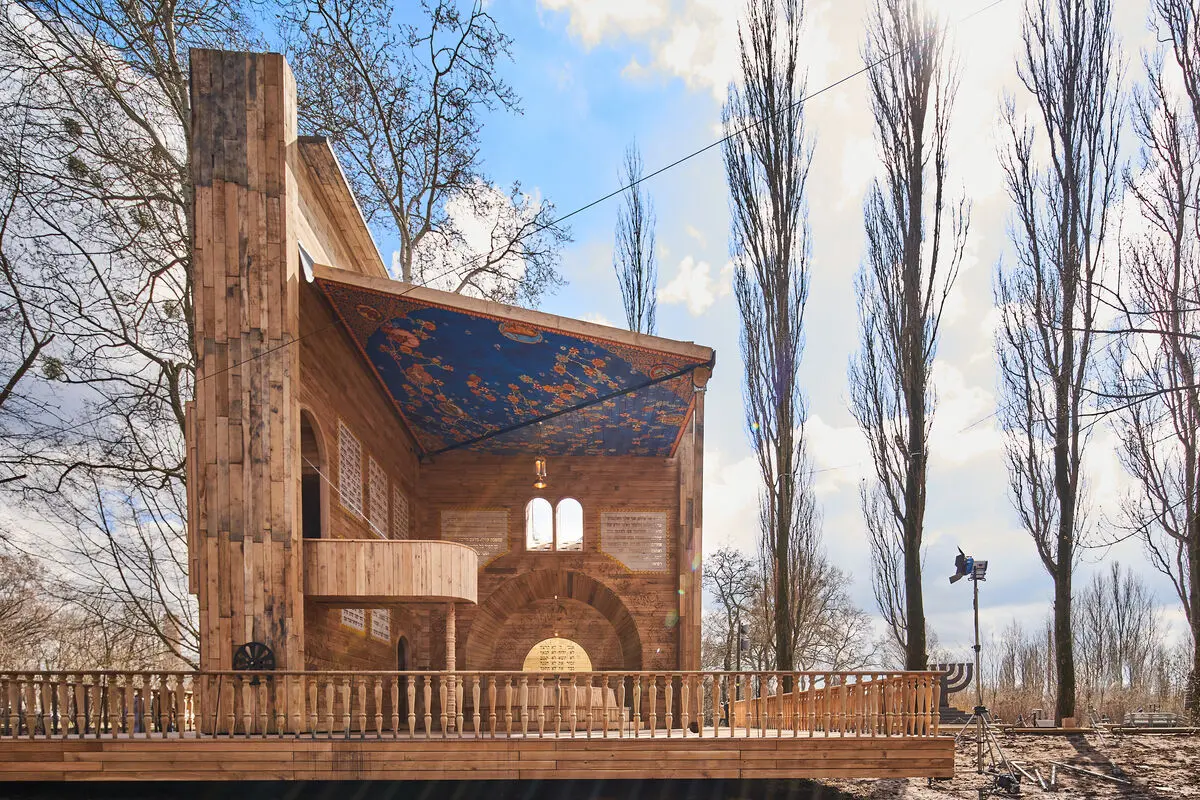
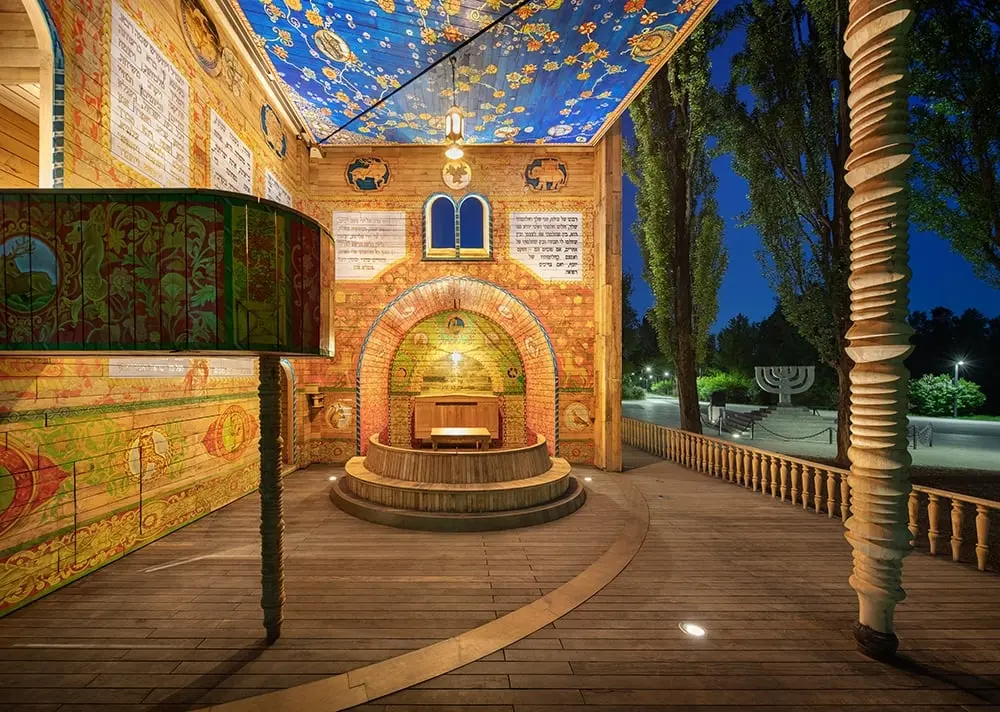
When I spoke with Kovalchuk, a former member of Barinova’s team, she lamented that the synagogue was nothing more than an “art object,” not a functional place for prayer and mourning. Indeed, it never occurred to me to sit down on its single, curved wooden bench—the diorama seemed too beautiful to disturb. Khrzhanovsky told me that people came there to pray every day, but I never saw someone do so in the five times I visited the site that week. It’s possible that I just missed them.
Wandering from one installation to another, I could not help but feel that these new sculptural projects seemed to be contributing to the existing memorial chaos of the site, not correcting it. As I walked, I often thought back to something that the Jewish historian Vitaliy Nakhmanovich had told me over coffee in Kyiv. As far as he was concerned, the installations represented the “apotheosis of post-modernism, where every step has no connection to the last.” He argued that the BYHMC’s plans broke the story into unrelated fragments that failed to capture what had happened at Babi Yar in all its dimensions; each memorial pointed visitors in a different direction, to a different aspect of the catastrophe. He also contended that the BYHMC had underestimated the size of the site where people were killed and their corpses burned. The reality is that it’s impossible to pinpoint the remains because they are everywhere—in the trees, in the soil, in the sand. This, at least, Khrzhanovsky understands: The whole site is a grave.
Nakhmanovich, who is spearheading the “Ukrainian Project” for an alternative memorial complex, was born and raised in Kyiv, and resolutely believes that Babi Yar should be memorialized as a distinctly Ukrainian site. He disdains the BYHMC’s outward-facing approach. “Who are we doing this for?” Nakhmanovich asked. Was all this construction for an international audience? For the global artistic elite? For the Jewish heritage industry and its customers? “This isn’t about history. This is about how we are to live today and tomorrow,” he said. But he also understood that building more statues would not make the terror go away, nor would reenacting it; the most powerful monuments, he argued, are not necessarily built: “The Passover Haggadah—that’s the only memorial to the flight out of Egypt,” he said. A narrative can outlast even the sturdiest stones.
The most powerful monuments, Nakhmanovich argued, are not necessarily built: “The Passover Haggadah—that’s the only memorial to the flight out of Egypt.”
ON ONE OF MY LAST DAYS in Kyiv, I returned not to Babi Yar but to the nearby Nyvky Park to meet with a group called “Susidy,” or “Neighbors.” Every week, Susidy ran public tours of Babi Yar and its environs—sometimes focused on the architecture of one neighborhood or another, sometimes on history. The day I joined them, Susidy was holding an architectural tour, conducted in Ukrainian, of a cluster of Soviet musical, artistic, and ballet conservatories on the park’s grounds. About 20 people showed up. A mother and daughter linked arms as they walked; two young girls who seemed to be sisters stared at their phones; several older women in headscarves interrupted the tour guide to share their own recollections. Inga Zaslavska, the creator and director of the program, introduced herself to me. Born and raised in a Jewish family in Kyiv, she noticed after the BYHMC was launched that a lot of the discussion about Babi Yar was happening among the intellectual elite or online. She wanted to bring it back down to earth, to the people who lived near the park and walked its grounds every day. Zaslavska suggested to Khrzhanovsky that they make Susidy an initiative under the umbrella of the BYHMC, and he took her up on the offer.
A hundred years ago, Nyvky Park and Babi Yar were part of the same strange, barren terrain. While Babi Yar has been transformed, Nyvky Park has retained more of its original topography: There, you can still see the harsh slants of the earth, the deep ravines filled with dried leaves. The tour guide, a local art historian, described what it looked like during the Soviet period, when Leonid Brezhnev used to frequent its ponds, and children queued for rowboat trips. Susidy was created with the goal of introducing locals to the history of their neighborhood, no matter how beautiful, horrific, or banal. The group has not focused specifically on telling stories of Jewish life and death, but has treated those stories as part of the warp and weave of the Ukrainian experience. At one point during the tour, the guide mentioned the word “menorah,” and I watched as one of the young girls in front of me looked up the term on her phone. “We want to introduce people to how Jewish culture was part of Kyivan life,” Zaslavska explained. “We say, ‘You are Kyivans. There were also Jews living here—let’s learn about this history.’ This way, people will start to feel closer to this story.”
After the tour, Zaslavska and I walked a few blocks to the metro station at Babi Yar together. I wanted to see the site one more time before I left Kyiv. A family pushed a stroller over the mirror field; children ran up to the stone cairns and peered into the viewfinders, and I listened as they yelled to tell their mothers that there were photographs inside. It was a sunny, crisp day, the first break in a week of rain, and I had to navigate around all of the toddlers riding scooters and tricycles down the path, past the explanatory posters of all that was buried beneath our feet. Some of the parents glanced at the signs, others walked right by. The park was part of their everyday life, and so were the memorials that kept springing up on its grounds. That’s the thing about memorials: People will use them however they want. Human behavior cannot be dictated. Neither can memory.
Human behavior cannot be dictated. Neither can memory.
Then Babi Yar was threatened with obliteration once more. On March 1st, the sixth day of the Russian invasion, a missile strike hit the area, killing five civilians. The missile left their bodies charred, the impact site aflame. The Russian bombers were aiming for the Kyiv TV tower, the tallest structure in the country, built by the Soviet government in 1973 on the grounds of the old Jewish cemetery. A building that the BYHMC had planned to turn into a museum about the Holocaust in Eastern Europe was directly hit and burned to the ground. The building that Khrzhanovsky planned to turn into a museum of “Soviet oblivion” stands 20 meters away. As of this writing the team has not been able to confirm whether it was also destroyed. “This rocket hit my heart,” Barinova wrote on Facebook. “I never allowed myself to think that something like this could happen in the 21st century. ‘Never again’ has in fact again occurred in Ukraine.”
The missile does not appear to have damaged the memorials, but we cannot know for sure. The war is ongoing, and much can still be destroyed. BYHMC was able to evacuate almost all of its staff and their families from Kyiv, though some remain in the besieged city. One joined the defense effort and was almost killed on the seventh day of the war, when fourteen members of his unit were shot by Russian forces. Zaslavska texted me from her evacuation site to tell me about the missile strike, asking me to spread the word. Susidy had launched an initiative to help deliver groceries to the elderly and sick, and to mothers with young children in Kyiv who had not been able to escape. Yakover was working to push international organizations to ban the Russian Federation from participating in art biennales, exhibitions, book fairs, and theaters around the world. In a statement to employees of his private equity firm, Mikhail Fridman called for the “bloodshed” to stop in Ukraine. Shortly afterwards, he was identified as a target of EU sanctions and forced to step down from the company; on March 3rd, he resigned from the supervisory board of the BYHMC due to the sanctions that had been imposed on him. Meanwhile, Kavatsiuk took shelter in the western mountains, where he tried to understand from afar just how much of his work had been destroyed.
The day after the missile strike, Ukrainian President Volodymyr Zelenskyy, who is Jewish and lost family members in the Holocaust, released a Hebrew-language statement on his Telegram channel: “We were shelled last night in Kyiv, and we all died again at Babyn Yar from a missile attack,” he wrote. Targeting the site amounted to “killing the Holocaust’s victims once again.” Kavatsiuk told me that members of the BYHMC staff are in close contact with Zelenskyy and his team, and have already begun collecting evidence of Russian war crimes in Ukraine to submit to the International Court of Justice in the Hague. “We believe that our mission is more alive now than ever,” he said. If Russian forces occupy and destroy Babi Yar, “there will be an oblivion of the Holocaust again. Our job is to help Ukraine stand and win this war for independence, to stay a democracy, to stay a free society. To finish the work that we started.”


